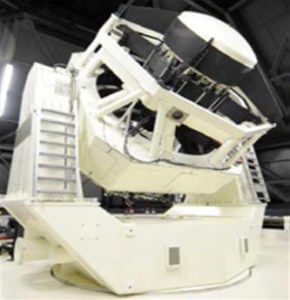Expert Tooling and Handling Enable Precision Large Format Coating
A Harsher Environment
When a government-sponsored astronomical telescope was set to be relocated to a new facility thousands of miles away, the decision was made to re-coat the mirrors with a more durable coating. The telescope had originally gone online in 2011 so its major optics had already been coated several times, and the new environment was expected to be much harsher. Being familiar with EMF’s unique large format coating capabilities, L-3 Technologies (now L3Harris Technologies), the prime contractor on the project, asked EMF to bid.
Due diligence in selecting a coating provider is a lengthy process for most large format optics, and it was notably so with this project because the optics were irreplaceable. The sheer size of the optics – a small mirror six feet in diameter weighing 1,800 lbs, and the other at eight feet in diameter and 2,400 lbs combined with their system design – necessitated highly specialized tooling equipment and handling procedures to move them in and around a facility without causing damage. After months of due diligence that involved capabilities surveys, interviews, and site visits, EMF was awarded the contract.

Collaboration and Transparency
Usually, when an optic is shipped to a coater it disappears only to reemerge once the work is completed. However, EMF embraces collaboration and the transparency customers yearn for throughout every step of the coating process. In this project, the multi-agency program management and mission-critical nature of the optics meant that program stakeholders were on-site and involved in every step of the process, which EMF easily accommodated. The internal and external teams worked closely to establish and execute a plan to safely strip and precisely re-coat each mirror within an aggressive timeline.

Looking Ahead
More than 80 years of experience with large format optics has taught the team to expect the unexpected. EMF’s robust processes allowed it to capture and swiftly pivot to address unexpected developments that could otherwise derail a project. This project had more than a few, not the least of which were:- A tooling redesign, when undisclosed requirements came to light.
- The discovery of a chemical compatibility concern.
- Heightened requirements to review and document every movement of and around the optics.


